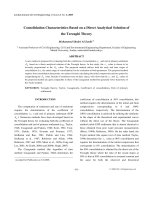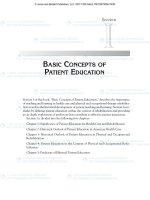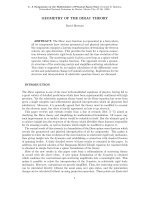- Trang chủ >>
- Khoa học tự nhiên >>
- Vật lý
Basic concepts of the quantum theory
Bạn đang xem bản rút gọn của tài liệu. Xem và tải ngay bản đầy đủ của tài liệu tại đây (279.14 KB, 14 trang )
Chapter 1
Basic Concepts of the Quantum
Theory (I): Heisenberg
Uncertainty Principle
1.1
Vectors and operators
In a classical system, there exists the direct correspondence between the state of the system
and the dynamical variables. Such direct correspondence does not exist in a quantum
system. In Dirac formulation of quantum mechanics [1], we can deal with two strange
creatures, vectors and operators, in a Hilbert space to describe the state and the dynamical
variable, respectively. In order to predict an experimental result, we have to project the
operator onto the vector.
1.1.1
State vectors
The state of a quantum object is described by a state vector, |ϕ (ket vector)(or equivalently by ϕ| (bra vector)), both of which describe the identical physical state. If the state
is a linear superposition state, expressed by
|ϕ =
Cn |ϕn
,
(1.1)
n
the corresponding bra vector is given by its hermitian adjoint
+
Cn∗
ϕ| =
ϕn | =
Cn |ϕn
n
.
(1.2)
n
With each pair of ket vectors |ψ and |ϕ , we can define a scalar product, ϕ|ψ =
ψ|ϕ ∗ , which is a c-number. The Schr¨
odinger wavefunction in q-representation, ψ(q) ≡
q|ψ is just the projected coordinate of a state vector |ψ as shown in Fig. 1.1. q| is an
eigen-bra vector of coordinate. In contrast to a real vector in an ordinary space, those
projected coordinates are complex numbers rather than real numbers. The c-number
coordinate is the probability amplitude, by which a quantum system is found in a position
eigen-state |qi . An important departure of the quantum theory from the classical theory
1
originates from (1.3) the fact that those probability amplitudes are c-numbers which carry
the amplitude and phase information simultaneously.
ψ : state vector
q3
q3 ψ
..
q ψ : Schrodinger wavefunction
q2
q1 ψ
q1
Figure 1.1: The state vector |ψ and the Schr¨odinger wavefunction ψ(q).
The Schr¨odinger wavefunction in p-representation is given by [2]
1
ϕ(p) ≡ p|ψ = √
2π
i
ψ(q) exp − pq dq
.
(1.3)
ϕ(p) and ψ(q) are a Fourier transform pair and includes exactly same information of a
quantum object.
If we know ψ(q) for all q values, it is said we have a complete information about the
system and this situation is called a “pure state”. If we do not know ψ(q) completely
but have only partial information, that situation is called a “mixed state”. A state vector
is insufficient to describe such a situation. We need a new mathematical tool (density
operator) for describing a mixed state, which will be introduced in Sec.2.1.
1.1.2
Linear operators
ˆ
If we associate each ket |a in the space to another ket |b by an operator D,
ˆ
|b = D|a
,
(1.4)
ˆ satisfies the relation
and D
ˆ 1 + |a2 ) = D|a
ˆ 1 + D|a
ˆ 2
D(|a
ˆ
ˆ
D(c|a
) = cD|a
,
,
(1.5)
(1.6)
ˆ is called a linear operator.
D
A linear operator which associates a ket vector |ψ to another ket vector |ϕ is also
called a projection operator, and is expressed by
Aˆ ≡ |ϕ ψ| .
(1.7)
A linear operator Aˆ+ which associates a bra vector ψ| to another bra vector ϕ| is
ˆ
called an adjoint operator to A:
2
lcl|ψ
ˆ
A=|ϕ
ψ|
ˆ
−−−−−−−−−−→ |ϕ = A|ψ
ˆ+ =|ψ ϕ|
A
ϕ| = ψ|Aˆ+
ψ| −−−−−−−−−−→
(1.8)
.
If Aˆ = Aˆ+ , the projection operator Aˆ is called an Hermitian operator (or self-adjoint
operator). If
ˆ = a|a
A|a
,
(1.9)
is satisfied, we have the following relations:
ˆ
a|A|a
= a a|a
∗
ˆ
a|A|a
= a|Aˆ+ |a = a∗ a|a
But Aˆ = Aˆ+ → a = a∗ .
(1.10)
The eigenvalue of an Hermitian operator is a real number.
If we measure a dynamical variable of a physical system, such as position, momentum,
angular momentum, energy, etc., the obtained values are always “real numbers”. Since the
eigenvalues of Hermitian operators are “real numbers”, we can let an Hermitian operator
represent a dynamical variable. An Hermitian operator is in this sense called an observable.
1.1.3
Probability interpretation
If an observable Aˆ is measured for a quantum object in a state |ψ , a measurement reˆ Which specific eigenvalue ai is obtained for a single
sult is one of the eigenvalues of A.
measurement is totally unknown. However, if we repeat the preparation of a quantum
object in the same state and the measurement of the same observable, the probability of
obtaining a specific result ai is equal to | ai |ψ |2 , which is the square of the Schr¨
odinger
wavefunction. This correspondence between the Schr¨
odinger wavefunction and the “ensemble” measurement is only connection between the quantum theory and experimental
result.
The sum of the probabilities for all possible measurement results is unity :
| q|ψ |2 =
q
ψ|q q|ψ = 1 ,
(1.11)
q
|q q| = Iˆ .
(1.12)
q
This relation(1.12) is called “completeness”. The eigen–states of an Hermitian operator
(observable) form a complete set. If an Hermitian operator has continuous eigenvalue
ˆ
rather than discrete eigenvalues, the completeness relation is replaced by |q q|dq = I.
3
Figure 1.2: Connection between the squared Schr¨
odinger wavefunction and the probability
of measurement results.
1.1.4
Single quantum system
The standard quantum theory describes a following ensemble measurement:
1. Preparation of an ensemble of identical systems
2. Noise-free measurement of a specific observable
The uncertainty (probability distribution) of the measurement results is attributed to the
characteristics of the initial state.
However, a following experimental situation is often encountered and becomes more
and more important recently:
1. Prepare one and only one quantum system
2. This is single quantum system couples to an unknown force (information source).
3. To extract the information of the unknown force, a second quantum system (called
probe) couples to the quantum system and the observable of the probe is measured.
4. Repeat the process 2 and process 3 to monitor a time dependent unknown force, as
shown in Fig. 1.3.
In order to analyze the above situation, we must know not only the influence of the unknown force on the quantum system but also the influence of the coupling of the quantum
probe and the measurement of the probe observable on the quantum system. We must
go beyond the standard probability interpretation of the Schr¨
odinger wavefunction. Dirac
formulation of quantum mechanics is particularly useful for this goal, as will be discussed
in Chapter 2.
4
system
F (t )
initial state
ψ
meas.
meas.
probe
meas. probe
probe
#2
#3
#1
Figure 1.3: A continuous monitoring unknown force F (t) by a single quantum system.
1.2
Heisenberg uncertainty principle
Today, the Heisenberg uncertainty principle is considered as the property of a “measured”
quantum system. In fact, it is usually formulated in the context of the probability interpretation for the two ideal quantum measurements of conjugate observables such as qˆ and
pˆ as shown in Fig. 1.2. However, when it was originally discussed by Heisenberg [3], it was
clearly the statement about the measurement error and back action, which are traced back
on the property of a “measuring” quantum probe. The goal of this section is to demonstrate that there are two types of uncertainty relations, one for the quantum system and
the other for the quantum probe and that these two uncertainty relations are independent
but intimately related. Even though it is referred to as “principle”, it is a consequence of
the fundamental assumption (postulate) of the quantum theory: commutation relation,
as we will see in this section.
1.2.1
von Neumann’s Doppler speed meter
incident photon
(ω )
object
v
m
reflected photon
(ω + δω )
Figure 1.4: von Neumann’s Doppler speed meter.
Let us consider the measurement of the momentum p by using the Dopper shift of a single
photon wavepacket in an experimental setup shown in Fig. 1.4. The single photon wave
packet acquires the Doppler shift: δω = − 2v
c ω upon the reflection from an object. We
assume a Fourier transform limited photon wavepacket : ∆ω · ∆τ ∼ 1. The measurement
error of the velocity (momentum) is then given by
∆vmeas.error
c ∆ω
c
=
2 ω
2ω∆τ
mc
2ω∆τ
∆pmeas.error
5
.
,
(1.13)
(1.14)
The object acquires a photon recoil in its momentum, 2 k = 2 cω , upon reflection of the
photon and changes its velocity by 2cmω . An exact time the photon recoil is transferred to
the object is, however, uncertain due to the finite pulse duration ∆τ of a single photon
wave packet, which results in the uncertainty in the center position of the object after
the collision between the object and the photon. This is the back action noise of the
measurement. Back action noise of the position is given by
2 ω ∆τ
ω∆τ
×
=
cm
2
cm
∆xback action
,
(1.15)
and thus we have
∆pmeas.error ·
∆xback action
.
2
This example illustrates the main elements of quantum measurements:
(1.16)
1. Measurement error ∆pmeas.error is governed by the uncertainty of the readout observable of a quantum probe ∆ω.
2. Back action noise ∆xback action is determined by the uncertainty of the conjugate
observable of a quantum probe ∆τ .
3. Uncertainty relation ∆pmeas.error ∆xback action
2 originates from the minimum uncertainty relation of a quantum probe ∆ω∆τ ∼ 1.
4. Irreversible process, i.e. death of photon and birth of photoelectron, occurs in the
quantum probe. After the death of a photon, the back action noise imposed on the
measured system becomes permanent. We even do not know what the back action
noise was. In this way, the measured system jump into a new state, which is an
essence of the collapse of the wavefunction (state reduction).
5. Initial uncertainty of the quantum system (∆pinitial , ∆xinitial ) introduces an independent source of the uncertainty for the measurement result, which stems from the
fact that the measured quantum system has its own uncertainty on the measured
observable and conjugate observable. Even if the measurement error is zero, the
measurement result is unpredictable due to this type of uncertainty. This is often
referred to as lack of causality in quantum measurements.
1.2.2
Commutation relation, the minimum uncertainty wavepacket and
squeezing
The most profound and fundamental postulate of the quantum theory probably a commutation relation. A certain pair of observables do not commute :
[ˆ
q , pˆ] = qˆpˆ − pˆqˆ = i
.
(1.17)
Classically, the position q and the momentum p commute. Therefore, the classical theory
and the quantum theory depart with each other due to this postulate. In general, the
commutation relation is expressed by
ˆ B]
ˆ = iCˆ
[A,
6
.
(1.18)
where Cˆ is an observable or real number. Let us introduce the fluctuating operators:
α
ˆ = Aˆ − Aˆ
ˆ− B
ˆ
βˆ = B
Then, we have
ˆ = iCˆ
[ˆ
α, β]
.
(1.19)
.
(1.20)
We assume linear operators α
ˆ and βˆ project the system state |ψ onto new states
α
ˆ |ψ
ˆ
β|ψ
=
ϕ
,
(1.21)
=
χ
,
(1.22)
We now introduce Schwartz inequality: ϕ|ϕ χ|χ ≥ | ϕ|χ |2 to obtain
α
ˆ 2 βˆ2 ≥ | α
ˆ βˆ |2
(1.23)
If we use
1 ˆ ˆ
1
α
ˆ βˆ = (ˆ
αβ + β α
ˆ ) + iCˆ ,
2
2
in (1.23), we can derive the Heisenberg uncertainty relation:
ˆ2 = α
∆Aˆ2 ∆B
ˆ 2 βˆ2
≥
≥
1
|α
ˆ βˆ + βˆα
ˆ + i Cˆ |2
4
1 ˆ 2
|C | .
4
(1.24)
(1.25)
For the equality to be held, we need
ˆ
1. α
ˆ |ψ = C1 β|ψ
⇒ two linear operators α
ˆ and βˆ project the system state |ψ
onto the identical state, except for the c-number C1 .
⇓
The mathematical definition of the minimum uncertainty state |ψ .
q3
αˆ ψ
βˆ ψ
ψ
q2
q1
Figure 1.5: Projection property of a minimum uncertainty state |ψ .
αβˆ + βˆα
ˆ |ψ = 0 ⇒ (C1 + C1∗ ) βˆ2 = 0
2. ψ|ˆ
7
ˆ βˆ2 = 0. Then, C1 must be a pure imaginary, so that
If |ψ is not an eigenstate of B,
we can write C1 = −ie−2r without loss of generality, where r is a real number.
Now, the minimum uncertainty state is constructed by the relation:
ˆ
α
ˆ |ψ = −ie−2r β|ψ
or
,
(1.26)
ˆ
ˆ )|ψ
(er Aˆ + ie−r B)|ψ
= (er Aˆ + ie−r B
.
(1.27)
The minimum uncertainty state |ψ is an eigenstate of the non- Hermitian operator er Aˆ +
ˆ with the complex eigenvalue e−r Aˆ + ier B
ˆ .
ie−r B
ˆ by using (1.26):
We can evaluate the quantum noise of the two observables Aˆ and B
ˆ
α
ˆ |ψ = −ie−2r β|ψ
ˆ2
∆Aˆ2 = e−4r ∆B
(1.28)
ψ|ˆ
α = ie−2r ψ|βˆ
ˆ 2 = 1 | Cˆ |2 , we obtain
If we substitute (1.28) into ∆Aˆ2 ∆B
4
∆Aˆ2
=
ˆ2
∆B
=
1 ˆ −2r
| C |e
2
1 ˆ 2r
| C |e
2
(1.29)
A real parameter r determines the distribution of the quantum noise between the two
conjugate observables under the constraint of the minimum uncertainty product. This
property is called “squeezing”.
1.2.3
Wave-particle duality
Let us consider a position-momentum minimum uncertainty state. The relevant eigenvalue
equation is given by
(ˆ
q − qˆ )|ψ = −ie−2r (ˆ
p − pˆ )|ψ .
(1.30)
By multiplying a bra-vector q | from the left and use the operator identity q |ˆ
p = i dqd ,
we have
d
(q − qˆ )
i
ψ(q ) = − −2r
+ pˆ ψ(q ) ,
(1.31)
dq
e
h
A solution of this first-order differential equation has a general form of
ψ(q ) = C3 exp −
(q − qˆ )2
i
+ pˆq
−2r
e
h
,
(1.32)
where the variance in qˆ is identified as
∆ˆ
q2 =
2
8
e−2r
.
(1.33)
∞
−∞ |ψ(q
If we use a normalization, ψ|ψ =
1
)|2 dq = 1, we can determine the coefficient
C3 , as C3 = 2π ∆ˆ
q 2 4 . Therefore, the Schr¨
odinger wavefunction in q-representation is
expressed by the Gaussian wavepacket:
ψ(q ) =
1
1
(2π ∆ˆ
q2 ) 4
exp −
(q − qˆ )2
i
+ pˆ q
2
4 ∆ˆ
q
.
(1.34)
The Fourier transform of (1.34) provides the Scr¨odinger wavefunction in p−representation:
ϕ(p ) =
=
1
√
2π
i
dq exp − p q
1
(2π ∆ˆ
p2 )
1
4
exp −
ψ(q )
(p − pˆ )2
i
− qˆ (p − pˆ )
2
4 ∆ˆ
p
.
(1.35)
We can express ψ(q ) in terms of the inverse Fourier transform of ϕ(p) as
ψ(q ) =
=
1
i
√
p q ϕ(p )
dp exp
2π
exp i qˆ pˆ
p
(p − pˆ )2
√
dp exp i (q − qˆ ) exp −
4 ∆ˆ
p2
2π
.
(1.36)
The Schr¨odinger wavefunction ψ(q ) consists of the linear superposition of de Broglie
waves with a wavelength λdB = ph and its Gaussian distribution centered at pˆ and with
a variance ∆ˆ
p2 . These plane waves interfere with each other. At positions close to qˆ ,
the phase rotation is slow so that “constructive interference” occurs. At positions far from
qˆ , the phase rotation is fast so that “destructive interference” occurs. In this way, a
particle is localized to the vicinity of the average position qˆ .
p′
ϕ ( p′) : distribution of de Broglie waves
p′
de Broglie
waves
destructive
interference
constructive interference
q′
qˆ
ψ (q ′) : localization of a particle
Figure 1.6: Phase space distribution of a minimum uncertainty wavepacket.
A particle-like state has an increased ∆ˆ
p2 and decreased ∆ˆ
q 2 , while a wave-like
state has a decreased ∆ˆ
p2 and increased ∆ˆ
q 2 . The wave-particle duality in quantum
mechanics is the result of quantum interference effect of de Broglie waves and traced back
to the fact that the Schr¨odinger wavefunction carries not only amplitude information but
also phase information.
9
1.2.4
Time evolution
In order to describe the time evolution of the minimum uncertainty wavepacket, we need a
further postulate, which is formulated in the so-called time dependent Schr¨
odinger equation.
A free particle prepared in a minimum uncertainty state at t = 0 experiences the
momomentum dependent phase shift (quantum diffusion), which results in the spread of
ˆ = pˆ2 , generate the time evolution of
the wavepacket. The Hamiltonian of the system, H
2m
the vector via Schr¨odinger equation:
i
∂
ˆ
|ψ = H|ψ
∂t
.
(1.37)
ˆ (t)|ψ(0) and substitute this
If we introduce the unitary evolution operator by |ψ(t) = U
relation into (1.37), we obtain
2
ˆ = exp − i pˆ t
U
2m
.
(1.38)
We multiply q| from the left of (1.38) and use dp|p p| = Iˆ and q|p =
we have the time-dependent Schr¨
odinger wavefunction as follows:
ψ(q, t) =
=
where ϕ(p, 0) =
pq
1
√
2π
exp i
1
(2π)1/4
i t
∆q +
2m∆q
1
(2π ∆ˆ
p2 )1/4
i p2
2m
ϕ(p, 0)dp
exp −
q2
4(∆q)2 +
exp −
− 12
2
pˆ )
−
exp − (p−
4 ∆ˆ
p2
i
√1
2π
exp
ipq
,
(1.39)
2i t
m
(if pˆ = qˆ = 0) ,
qˆ (p − pˆ ) is the initial wavepacket. As
we can see, the momentum uncertainty is preserved,
∆ˆ
p(t)2 = ∆ˆ
p(0)2
,
(1.40)
but the position uncertainty increases,
∆ˆ
q (t)2 = ∆ˆ
q (0)2 +
2 t2
4m2 ∆ˆ
q2
.
(1.41)
In order to preserve the minimum uncertainty wavepacket against the quantum diffusion, we need a restoring force to confine the particle position. One example of such a
restoring force is a harmonic potential:
2
ˆ = pˆ + 1 k qˆ2
H
2m 2
.
(1.42)
The minimum uncertainty wavepackets preserve their features in the precense of the harmonic potential. The representative examples of such states as coherent state, phase
squeezed state and amplitude squeezed state, are schematically shown in Fig. 1.8. The
characteristics of those states will be described in Chapter 4.
10
quantum
diffusion
p
final wavepacket
q
initial wavepacket
ψ (t )
correlation between
q and p
ψ (0)
no correlation between
q and p
Figure 1.7: The initial and final wavepackets under the quantum diffusion.
Figure 1.8: Coherent state, phase squeezed state and amplitude squeezed state in a harmonic potential.
11
1.2.5
Simultaneous measurement of two conjugate observables
Let us consider the simultaneous measurement of the position qˆ and the momentum pˆ of
a quantum object. For this purpose we couple a quantum object (system) to a quantum
probe which has two readout observables x
ˆ and yˆ[4]. Such a compound system is described
ˆ
ˆ
ˆ 2 , where the subscripts 1 and 2 refer to the
by the tensor product space : H = H1 ⊗ H
system and probe. The two measured observables are represented by qˆ = qˆ1 ⊗ Iˆ2 and
pˆ = pˆ1 ⊗ Iˆ2 .
Nˆ x
Cx
qˆ1
pˆ1
xˆ2
yˆ2
Cy
system
probe
Nˆ y
Figure 1.9: A simultaneous measurement of qˆ and pˆ in the coupled system-prove setup.
The two readout observables are described by
ˆx
x
ˆ = Cx qˆ + N
,
(1.43)
ˆy
yˆ = Cy pˆ + N
,
(1.44)
ˆx and N
ˆy are the noise operators. We
where Cx and Cy are the coupling constants and N
assume no bias condition:
ˆx = ψ1 | ψ2 |Iˆ1 ⊗ N
ˆx2 |ψ2 |ψ1 = 0 ,
N
(1.45)
ˆy = ψ1 | ψ2 |Iˆ1 ⊗ N
ˆy2 |ψ2 |ψ1 = 0 .
N
(1.46)
In order to measure the two readout observables xˆ and yˆ simultaneously, we require
[ˆ
x, yˆ] = 0 ,
(1.47)
ˆx , N
ˆy ] + [N
ˆx , Cy pˆ] + [Cx qˆ, N
ˆy ] = 0 .
Cx Cy [ˆ
q , pˆ] + [N
(1.48)
which results in
The internal noise of the quantum probe is uncorrelated with the quantum system, so we
have
ˆx , pˆ] = N
ˆx pˆ − pˆ N
ˆx = 0 ,
[N
(1.49)
ˆy ] = 0 .
[ˆ
q, N
(1.50)
Thus, the noise operators must satisfy
ˆx , N
ˆy ] = −Cx Cy [ˆ
[N
q , pˆ] = − Cx Cy
12
.
(1.51)
We now introduce the normalized readout observables by
qˆobs ≡
ˆx
N
x
ˆ
= qˆ +
Cx
Cx
,
(1.52)
pˆobs ≡
ˆy
N
yˆ
= pˆ +
Cy
Cy
.
(1.53)
As expected, there is no bias in the measurements of qˆ and pˆ : qˆobs = qˆ , pˆobs = pˆ
The uncertainty product is now evaluated as
2
∆ˆ
qobs
∆ˆ
p2obs
∆ˆ
q2 +
=
2
≥
≥
4
ˆ2
∆N
x
Cx2
2
+
4
+2
∆ˆ
p2 +
2
4
×
ˆ2
∆N
y
Cy2
(1.54)
2
4
2
The equality holds when and only when the quantum system is in a minimum uncerˆ2
tainty state and the quantum probe has the matched internal noise : ∆CN2x = ∆ˆ
q 2 and
ˆ2
∆N
y
Cy2
x
∆ˆ
p2
=
.
Inherent and irreducible lower bound for the simultaneous measurements of two conjugate observables is four times larger than the Heisenberg uncertainty product.
13
Bibliography
[1] P. A. M. Dirac. The Principles of Quantum Mechanics. Clarendon Press, Oxford,
1958.
[2] W. H. Louisell. Quantum statistical properties of radiation. Wiley, New York, 1973.
[3] W. Heisenberg. The actual content of quantum theoretical kinematics and mechanics.
Z. Phys., 43:172, 1927.
[4] E. Arthurs and J. L. Kelly. On simultaneous measurement of a pair of conjugate
observables. Bell System Technical Journal, 44:725, 1965.
14









